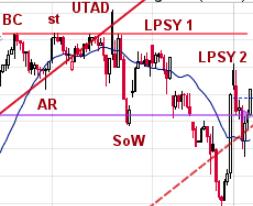Understanding Wyckoff Methodology in Intraday Trading
The Wyckoff method is a renowned technical analysis approach developed by Richard D. Wyckoff. Traders and investors worldwide use this method to study the market’s behavior. Thus, it’s worth evaluating how it works in the intraday timeframe to enhance your trading proficiency.
Wyckoff’s method explores the relationship between supply and demand forces and how they influence price movements. It broadens the horizon for those who want to understand the real battle in the markets: the clash between buyers and sellers. In this method, volume and price data are analyzed thoroughly to predict future price movements.
Wyckoff Event & Phases
Wyckoff’s method employs charting to study the stock market. It primarily focuses on identifying periods of accumulation (buying) and distribution (selling). Significant intraday market movements normally undergo these periods. Subsequently, Wyckoff’s method decomposes them into various events and phases.
The accumulation phase often signifies moments when smart money is acquiring positions. It’s characterized by price ranging sideways for some time, and it happens after a downward price trend. Fear and panic predominate in the market during this phase.
Conversely, the distribution phase is when smart money is offloading their positions. This phase occurs after an upward price trend, when the market is dominated by greed and complacency.
Wyckoff’s method allows traders to perceive these scenarios unfolding within the intraday timeframe, hence positioning themselves appropriately.
Wyckoff Price Cycle
Understanding the Wyckoff price cycle is crucial. It follows a general sequence which includes accumulation, mark-up, distribution, and mark-down.
In the intraday timeframe, the accumulation phase is a period of consolidation before the price increases, known as the mark-up. The distribution phase comes in when the price reaches its peak, and consolidation occurs again before the price begins to decline, marking down.
Wyckoff’s Law of Cause and Effect
Wyckoff’s law of cause and effect is pivotal in the intraday timeframe. This law denotes that a cause (accumulation or distribution phase) will result in an effect (mark-up or mark-down).
The longer the accumulation or the distribution phase, the greater the ensuing price move will be. This insight enables traders to establish their positions during the accumulation phase, hold through the mark-up phase, and consequently sell during the distribution phase.
Volume & Price Analysis
The Wyckoff method places substantial weight on price and volume analysis. Analyzing volume in relation to price movements can give traders an idea of the strength of a trend. If price is increasing with increasing volume, the upward trend is likely strong. However, if the volume is decreasing while the price is increasing, this may signal a weaker upward trend. Utilizing this strategy within an intraday timeframe can provide vital insights into the market and its potential trends.
Wyckoff’s Three Laws
The three fundamental laws of the Wyckoff method; law of supply and demand, law of cause and effect, and the law of effort vs. result, remain crucial in the intraday timeframe.
Understanding imbalance between supply and demand can give the trader a hint on the direction of the trend. The law of cause and effect helps in anticipatory trading based on the accumulation period. Also, when effort (volume) and result (price) are not proportional, it’s time to be cautious.
In the dynamic world of intraday trading, implementing Wyckoff’s theories can be highly beneficial. Comprehending the accumulation and distribution phases, price cycles, laws, and the integration of volume and price, traders can make effective and informed trade decisions within the intraday timeframe.




